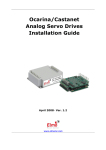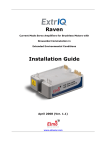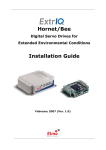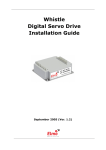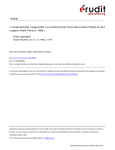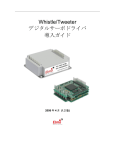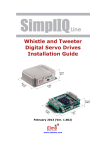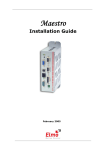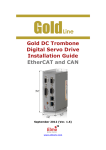Download Elmo Computer Hardware BUT- X/YYY User's Manual
Transcript
Dragonfly/Butterfly Current Mode Servo Amplifiers for DC Brush and Brushless Motors with Trapezoidal Commutation in Extended Environmental Conditions Installation Guide April 2008 (Ver. 1.1) www.elmomc.com Notice This guide is delivered subject to the following conditions and restrictions: This guide contains proprietary information belonging to Elmo Motion Control Ltd. Such information is supplied solely for the purpose of assisting users of the Dragonfly and Butterfly servo drives in their installation. The text and graphics included in this manual are for the purpose of illustration and reference only. The specifications on which they are based are subject to change without notice. Elmo Motion Control and the Elmo Motion Control logo are trademarks of Elmo Motion Control Ltd. Information in this document is subject to change without notice. Document No. MAN-DRBUIG Copyright 2008 Elmo Motion Control Ltd. All rights reserved. Hornet/Bee Catalog Numbers: DRA- X/YY BUT- X/YYY Continuous Current (Amps) Maximum DC Operating Voltage Continuous Current (Amps) Maximum DC Operating Voltage Related Products: Evaluation Board Catalog Number Evaluation Board User Manual OCA-EVLBRD-1 (available upon request) MAN-EVLBRD-OCA (available on our web site) Revision History: Ver. 1.1 April 2008 Updated Power Ratings Table in Appendix Ver. 1.0 June 2007 Initial release (MAN-DRBUIG.PDF) Elmo Motion Control Ltd. Elmo Motion Control Inc. Elmo Motion Control GmbH 64 Gisin St., P.O. Box 463 Petach Tikva 49103 Israel 1 Park Drive, Suite 12 Westford, MA 01886 USA Steinkirchring 1 D-78056, Villingen-Schwenningen Germany Tel: +972 (3) 929-2300 Fax: +972 (3) 929-2322 Tel: +1 (978) 399-0034 Fax: +1 (978) 399-0035 Tel: +49 (0) 7720-85 77 60 Fax: +49 (0) 7720-85 77 70 [email protected] [email protected] [email protected] www.elmomc.com Dragonfly/Butterfly Installation Guide MAN-DRBUIG (Ver. 1.1) Contents Chapter 1: Safety Information ............................................................................................... 1-1 1.1 Warnings.................................................................................................................... 1-2 1.2 Cautions ..................................................................................................................... 1-2 1.3 Directives and Standards ......................................................................................... 1-3 1.4 CE Mark Conformance ............................................................................................. 1-3 1.5 Warranty Information............................................................................................... 1-4 Chapter 2: Introduction........................................................................................................... 2-1 2.1 ExtrIQ Product Family.............................................................................................. 2-1 2.2 Product Description .................................................................................................. 2-2 2.3 Highlights .................................................................................................................. 2-2 2.4 Fault Protection ......................................................................................................... 2-3 2.5 How to Use this Guide ............................................................................................. 2-3 Chapter 3: Installation ............................................................................................................ 3-1 3.1 Before You Begin....................................................................................................... 3-1 3.1.1 Site Requirements ............................................................................................. 3-1 3.2 Unpacking the Amplifier.......................................................................................... 3-1 3.3 Dimensions ................................................................................................................ 3-2 3.3.1 Butterfly Dimensions........................................................................................ 3-2 3.3.2 Dragonfly Dimensions ..................................................................................... 3-3 3.4 Mounting ................................................................................................................... 3-3 3.4.1 Butterfly.............................................................................................................. 3-3 3.4.2 Dragonfly ........................................................................................................... 3-3 3.5 Integrating the Dragonfly and Butterfly on a PCB ................................................ 3-4 3.5.1 Traces.................................................................................................................. 3-4 3.5.2 Grounds and Returns....................................................................................... 3-5 3.6 Pin Functions ............................................................................................................. 3-6 3.6.1 Pinouts................................................................................................................ 3-6 3.6.2 Connector J1 ...................................................................................................... 3-7 3.7 Dragonfly/Butterfly Connection Diagram............................................................. 3-9 3.8 Evaluation Board and Cable Kit .............................................................................. 3-9 3.9 DC Power Supply.................................................................................................... 3-10 3.10 Heat Dissipation...................................................................................................... 3-12 3.10.1 Butterfly............................................................................................................ 3-12 3.10.1.1 Thermal Data......................................................................................... 3-12 3.10.1.2 Heat Dissipation Data........................................................................... 3-12 3.10.1.3 How to Use the Charts ......................................................................... 3-13 3.10.2 Dragonfly ......................................................................................................... 3-13 Chapter 4: Servo Control Operation ..................................................................................... 4-1 4.1 Current Command Input ......................................................................................... 4-1 4.2 External Current Limit - Continuous (ECLC) ........................................................ 4-1 4.2.1 External Voltage............................................................................................ 4-1 4.2.2 External Resistor ............................................................................................... 4-2 4.2.3 External Current Limit - Peak (ECLP) ........................................................... 4-2 i Dragonfly/Butterfly Installation Guide Contents MAN-DRBUIG (Ver. 1.1) 4.2.4 4.2.5 4.2.6 External Voltage................................................................................................ 4-2 External Resistor ............................................................................................... 4-3 Latch Mode (LM) .............................................................................................. 4-3 4.3 Status Indications ...................................................................................................... 4-3 Appendix: Specifications ......................................................................................................A-1 A.1 General Specifications..............................................................................................A-1 A.1.1 Butterfly............................................................................................................. A-1 A.1.2 Dragonfly .......................................................................................................... A-2 A.2 Environmental Specifications .................................................................................A-2 A.3 Standards Compliance.............................................................................................A-3 A.3.1 Quality Assurance ........................................................................................... A-3 A.3.2 Design................................................................................................................ A-3 A.3.3 Safety ................................................................................................................. A-3 A.3.4 EMC ................................................................................................................... A-4 A.3.5 Workmanship................................................................................................... A-4 A.3.6 PCB .................................................................................................................... A-4 A.3.7 Packing .............................................................................................................. A-4 A.3.8 WEEE* ............................................................................................................... A-4 A.3.9 RoHS.................................................................................................................. A-4 ii Dragonfly/Butterfly Installation Guide MAN-DRBUIG (Ver. 1.1) Chapter 1: Safety Information In order to achieve the optimum, safe operation of the Dragonfly and Butterfly servoamplifiers, it is imperative that you implement the safety procedures included in this installation guide. This information is provided to protect you and to keep your work area safe when operating the Dragonfly and Butterfly and accompanying equipment. Please read this chapter carefully before you begin the installation process. Before you start, ensure that all system components are connected to earth ground. Electrical safety is provided through a low-resistance earth connection. Only qualified personnel may install, adjust, maintain and repair the servo drive. A “qualified person” has the knowledge and authorization to perform tasks such as transporting, assembling, installing, commissioning and operating motors. The Dragonfly and Butterfly servo drive contain electrostatic-sensitive components that can be damaged if handled incorrectly. To prevent any electrostatic damage, avoid contact with highly insulating materials, such as plastic film and synthetic fabrics. Place the product on a conductive surface and ground yourself in order to discharge any possible static electricity build-up. To avoid any potential hazards that may cause severe personal injury or damage to the product during operation, keep all covers and cabinet doors shut. The following safety symbols are used in this manual: Warning: This information is needed to avoid a safety hazard, which might cause bodily injury. Caution: This information is necessary for preventing damage to the product or to other equipment. Note: This is auxiliary information that ensures the correct operation of the equipment. 1-1 Dragonfly/Butterfly Installation Guide Safety Information MAN-DRBUIG (Ver. 1.1) 1.1 Warnings Cleaning after soldering To avoid the damage of the product's acrylic coating the Dragonfly/Butterfly must not be cleaned after soldering by dissolving solvents and /or "water" cleaning process. For more details: http://www.elmomc.com/applications/article/Soldering-andCleaning_Application-Note.pdf To avoid electric arcing and hazards to personnel and electrical contacts, never connect/disconnect the servo drive while the power source is on. Power cables can carry a high voltage, even when the motor is not in motion. Disconnect the Dragonfly and Butterfly from all voltage sources before they are opened for servicing. The Dragonfly and Butterfly servo drive contain grounding conduits for electric current protection. Any disruption to these conduits may cause the instrument to become hot (live) and dangerous. After shutting off the power and removing the power source from your equipment, wait at least 1 minute before touching or disconnecting parts of the equipment that are normally loaded with electrical charges (such as capacitors or contacts). Measuring the electrical contact points with a meter, before touching the equipment, is recommended. 1.2 Cautions The Dragonfly and Butterfly servo drives contain hot surfaces and electrically-charged components during operation. The maximum DC power supply connected to the instrument must comply with the parameters outlined in this guide. When connecting the Dragonfly and Butterfly to an approved 12 ~ 95 VDC auxiliary power supply, connect them through a line that is separated from hazardous live voltages using reinforced or double insulation in accordance with approved safety standards. Before switching on the Dragonfly and Butterfly, verify that all safety precautions have been observed and that the installation procedures in this manual have been followed. 1-2 Dragonfly/Butterfly Installation Guide Safety Information MAN-DRBUIG (Ver. 1.1) 1.3 1-3 Directives and Standards The Dragonfly and Butterfly conform to the following industry safety standards: Safety Standard Item In compliance with MIL-STD-704 Aircraft, Electric Power Characteristics In compliance with MIL-STD-810 Environmental Engineering Considerations and Laboratory Tests In compliance with MIL-STD-1275 Characteristics of 28 Volt DC Electrical Systems in Military Vehicles In compliance with MIL-STD-461 Requirements for the Control of Electromagnetic Interference Characteristics of Subsystems and Equipment In compliance with MIL-HDBK-217 Reliability Prediction of Electronic Equipment In compliance with ISO-9001:2000 Quality Management In compliance with UL508c Power Conversion Equipment In compliance with UL840 Insulation Coordination, Including Clearance and Creepage Distances of Electrical Equipment In compliance with UL60950-1 (formerly UL1950) Safety of Information Technology Equipment, Including Electrical Business Equipment In compliance with EN60204-1 Low Voltage Directive, 73/23/EEC The Dragonfly and Butterfly servo drives have been developed, produced, tested and documented in accordance with the relevant standards. Elmo Motion Control is not responsible for any deviation from the configuration and installation described in this documentation. Furthermore, Elmo is not responsible for the performance of new measurements or ensuring that regulatory requirements are met. 1.4 CE Mark Conformance The Dragonfly and Butterfly servo drives are intended for incorporation in a machine or end product. The actual end product must comply with all safety aspects of the relevant requirements of the European Safety of Machinery Directive 98/37/EC as amended, and with those of the most recent versions of standards EN60204-1 and EN292-2 at the least. According to Annex III of Article 13 of Council Directive 93/68/EEC, amending Council Directive 73/23/EEC concerning electrical equipment designed for use within certain voltage limits, the Butterfly and Dragonfly meet the provisions outlined in Council Directive 73/23/EEC. The party responsible for ensuring that the equipment meets the limits required by EMC regulations is the manufacturer of the end product. Dragonfly/Butterfly Installation Guide Safety Information MAN-DRBUIG (Ver. 1.1) 1.5 Warranty Information The products covered in this manual are warranted to be free of defects in material and workmanship and conform to the specifications stated either within this document or in the product catalog description. All Elmo drives are warranted for a period of 12 months from the time of installation, or 18 months from time of shipment, whichever comes first. No other warranties, expressed or implied — and including a warranty of merchantability and fitness for a particular purpose — extend beyond this warranty. 1-4 Cymbal Installation Guide Introduction MAN-CYMIG (Ver. 1.1) Chapter 2: Introduction This Installation Guide is intended for design engineers who are integrating Elmo Motion Control Cymbal servo amplifiers into a machine. 2.1 Product Description The Cymbal series of servo amplifiers is designed to operate in the current mode controlling permanent-magnet trapezoidal brushless motor and DC brush motor. The Cymbal exhibits “the highest density of power and intelligence” and can deliver up to 11.3 kW of continuous power or 13.6 k W of peak power in a most compact and efficient package. The Cymbal operates from a DC power source in the range of 12 ~ 195 VDC. The Power stage of the Cymbal is fully isolated from other sections of the Cymbal, such as the control stage and the heatsink. This contributes very significantly to the safety and the EMI immunity of the Cymbal. In addition it simplifies the requirements of the DC power supply used to power the DC bus of the Cymbal and allows also the operation with a non-isolated DC power source. The Cymbal incorporates full custom mixed analog/digital ICs and a hybrid power stage. The basic configuration is a current mode amplifier targeting the OEM market. As such, no trimmers are used in the basic version. In addition to its compliance with relevant MIL standards, the Cymbal amplifier also meets UL508c and the relevant CE regulations. The Cymbal power stage is implemented on ceramic substrates. This design enables very high thermal conductivity, high current carrying capacity, improved EMC and good mechanical strength. The control section is implemented by dedicated custom ICs that contribute to enhanced performance and reliability. 2.2 Standard Features • Operates in current mode • Internal DC-to-DC converter, which allows for operation from a single supply • Zero dead-band • Excellent linearity • One differential input • Motor current monitor • Current gain change for low inductance motors • Remote current gain control • Status indication and remote control functions by four open collector transistors • External continuous and peak current-limit adjustments • Package: plated-aluminum base plate, plastic housing, UL94V0 recognized Ultra-lightweight of 700 grams (24.7 oz) • 2-1 Cymbal Installation Guide Introduction MAN-CYMIG (Ver. 1.1) 2.3 Fault Protection Built-in protection against possible fault conditions, including: • Shorts between the outputs or between each output and the power input/return • Over-heating • Under/over voltage • Failure of internal power supplies • Latch mode for each protective feature 2.4 How to Use this Guide Installation is the first step in integrating and operating the Elmo Cymbal servo amplifiers. After carefully reading the safety instructions in the first chapter, the following chapters provide you with installation instructions as follows: Chapter 3, Installation, provides step-by-step instructions for unpacking, mounting and connecting the Cymbal. Chapter 4, Servo Control Operation, explains how to control the operation of the servo amplifier. The Appendix, Technical Specifications, lists all the drive ratings and specifications. 2-2 Dragonfly/ Butterfly Installation Guide Installation MAN-DRBUIG (Ver. 1.1) 3-1 Chapter 3: Installation 3.1 Before You Begin 3.1.1 Site Requirements You can guarantee the safe operation of the Dragonfly and Butterfly by ensuring that they are installed in an appropriate environment. Feature Value Ambient operating temperature -40 °C to +70 °C (-40 °F to 160 °F) Maximum relative humidity 95% non-condensing Operating area atmosphere No flammable gases or vapors permitted in area Note: Models for extended environmental conditions are available. The Dragonfly and Butterfly dissipate their heat by convection. The maximum ambient operating temperature of –40 °C to +70 °C (-40 °F to 160 °F) must not be exceeded. 3.2 Unpacking the Amplifier To unpack the Dragonfly and Butterfly: Carefully remove the servo amplifier from the box and the Styrofoam. 1. Check the amplifier to ensure that there is no visible damage to the instrument. If any damage has occurred, report immediately to the carrier that delivered your amplifier. 2. To ensure that the Dragonfly or Butterfly you have unpacked is the appropriate type for your requirements, find the part number sticker on the side of the product: The P/N gives the type designation as follows: BUT- X/YYY Continuous Current (Amps) Maximum DC Operating Voltage Dragonfly/ Butterfly Installation Guide Installation MAN-DRBUIG (Ver. 1.1) 3-2 DRA- X/YY Continuous Current (Amps) Maximum DC Operating Voltage 3. Verify that the Dragonfly or Butterfly type is the one that you ordered, and ensure that the voltage meets your specific requirements. 3.3 3.3.1 Dimensions Butterfly Dimensions Figure 3-1: Butterfly Dimensions Dragonfly/ Butterfly Installation Guide MAN-DRBUIG (Ver. 1.1) 3.3.2 Installation 3-3 Dragonfly Dimensions Figure 3-2: Dragonfly Dimensions 3.4 3.4.1 Mounting Butterfly The Butterfly was designed for mounting on a printed circuit board (PCB). It is connected by 2mm pitch 0.51 mm square pins. When designing the Butterfly into a device, be sure to leave about 1 cm (0.4") outward from the heatsink to enable free air convection around the Butterfly. We recommend that the Butterfly be soldered directly to the board. Alternatively, the Butterfly can be attached to socket connectors mounted on the PCB. If the PCB is enclosed in a metal chassis, we recommend that the Butterfly be screw-mounted to it as well to help with heat dissipation. The Butterfly has screw-mount holes on each corner of the heatsink for this purpose. 3.4.2 Dragonfly The Dragonfly was designed for mounting on a printed circuit board (PCB). It is connected by 2mm pitch 0.51 mm square pins. When designing the Dragonfly into a device, be sure to leave about 1 cm (0.4") outward from the lower board to enable free air convection around the Dragonfly. We recommend that the Dragonfly be soldered directly to the board. Alternatively, the Dragonfly can be attached to socket connectors mounted on the PCB. Note: Elmo recommends you leave approximately 1 cm (0.4 in) of space on the side opposite the terminals to allow for free air convection. Dragonfly/ Butterfly Installation Guide Installation MAN-DRBUIG (Ver. 1.1) 3.5 3-4 Integrating the Dragonfly and Butterfly on a PCB The Dragonfly and Butterfly are designed to be mounted on a PCB, either by soldering the pins directly to the PCB or by using suitable socket connectors. In both cases the following rules apply: 3.5.1 Traces 1. The size of the traces on the PCB (thickness and width) is determined by the current carrying capacity required by the application. The rated continuous current limit (Ic)of the Dragonfly and Butterfly is the current used for sizing the motor traces (M1, M2, M3 and PE) and power traces (VP+, PR and PE). For control, feedbacks and Inputs/ outputs conductors the actual current is very small but “generous” thickness and width of the conductors will contribute to a better performance and lower interferences. 2. The traces should be as short as possible to minimize EMI and to minimize the heat generated by the conductors. 3. The spacing between the high voltage conductors (VP+, PR, M1, M2, M3, VL) must be at least: Surface layer: 1.5 mm Internal layer: 0.10 mm Complying with the rules above will help satisfy UL safety standards, MIL-STD-275 and the IPC-D-275 standard for non-coated conductors, operating at voltages lower than 100VDC and at "unlimited altitudes" (above 10,000 meters – 30,000 feet). Dragonfly/ Butterfly Installation Guide Installation MAN-DRBUIG (Ver. 1.1) 3.5.2 3-5 Grounds and Returns The “Returns” of the Dragonfly and Butterfly are structured internally in a star configuration. The returns in each functional block are listed below: Functional Block Return Pin Power PR (Power Return) Internal Switch Mode P.S. PR (Power Return) Control section Internal, not accessible Feedback SUPRET (J2/2) The returns above are all shorted within the Dragonfly and Butterfly in a topology that results in optimum performance. 1. When wiring the traces of the above functions, on the Integration Board, the Returns of each function must be wired separately to its designated terminal on the Dragonfly and Butterfly. DO NOT USE A COMMON GROUND PLANE. Shorting the commons on the Integration Board may cause performance degradation (ground loops, etc). 2. Return Traces: The return traces should be as large as possible, but without shorting each other, and with minimal cross-overs. 3. Main Power Supply and Motor Traces: The power traces must be kept as far away as possible from the feedback and control traces. 4. PE Terminal: The PE terminal is connected directly to the Butterfly's heatsink or to the Dragonfly's two PE strips on its lower board. In the Butterfly, the heatsink serves as an EMI common plane. The PE terminal should be connected to the system's Protective Earth. Any other metallic parts (such as the chassis) of the assembly should be connected to the Protective Earth as well. 5. Under normal operating conditions, the PE trace carries no current. The only time these traces carry current is under abnormal conditions (such as when the device has become a potential shock or fire hazard while conducting external EMI interferences directly to ground). When connected properly the PE trace prevents these hazards from affecting the drive. Follow these instructions to ensure safe and proper implementation. Failure to meet any of the above-mentioned requirements can result in drive/controller/host failure. Dragonfly/ Butterfly Installation Guide Installation MAN-DRBUIG (Ver. 1.1) 3.6 3-6 Pin Functions The Dragonfly and Butterfly are PCB mounted analog servo drives. Their pinouts are described below. 3.6.1 No. Pins Pinouts Type Port Function J1 I/O connector 2 M3 Motor power output 3 2 M2 Motor power output 2 M1 Motor power output 1 PE Protective earth 2 PR Power input return 2 VP+ Positive power input 1 VL Auxiliary power input 2X11 2 2 2 mm Pitch 0.51 mm SQ Connector Location Dragonfly/ Butterfly Installation Guide Installation MAN-DRBUIG (Ver. 1.1) 3.6.2 3-7 Connector J1 Pin # Short Form Function Description 1 EN+ Enable + 2 AOK Amplifier OK 3 4 SO1 HA Status output 1 Hall A input 5 HB Hall B input Positive voltage input of the “Amplifier Enable” function. To enable operation of the amplifier, the optocoupler must be energized by applying voltage between this pin (+) and pin J1/22 (-). The optocoupler is isolated from the amplifier. See Figure 3-4. “OFF” voltage: 0 V < Vin < 1 V. “ON” voltage: 2.5 V < Vin < 10 V, 5 V typically with current consumption 2.5 mA. When the amplifier under normal operating conditions, this output is in the “active low“ state. When a failure occurs, this output is changed to the “open” state. The optocoupler is an isolated, open collector NPN type. See Figure 3-4. Maximum voltage = 30 V Maximum current = 8 mA “On” voltage: V OUT(On) < 0.8 V Refer to Section 4.3. Specifications same as in pin J1/2. Logic levels: TTL Maximum input voltage: 15 VDC. Logic levels: TTL Maximum input voltage: 15 VDC. 6 HC Hall C input 7 LATCH Latch mode 8 ECLRET 9 ECLC Current limits return External current limit continuous 10 CM 11 CREF+ Current command positive 12 CREF- 13 CMRET Current command negative Current monitor return Current monitor Logic levels: TTL. Maximum input voltage: 15 VDC. Latch mode input. For more details see the Latch Mode section in Chapter 4. Current limit signals return. External voltage scales down the rated value. Voltage range: 0 V to 3.75 V (3.75 V = rated Ic) Refer to Section 4.2. Analog output with a scale of ± 3.9 V for ± Ip. Output resistance: 1 kΩ Positive input of a differential amplifier: Input operating voltage range: ±3.75 V Maximum input voltage: ±20 V Maximum common mode voltage: ±6 V Differential input impedance: 40 kΩ Refer to Section 4.1. Negative input of a differential amplifier. Same specification as in pin J1/11. Current monitor (CM) signal return. Dragonfly/ Butterfly Installation Guide Installation MAN-DRBUIG (Ver. 1.1) Pin # Short Form 14 Function Description ECLP External current limit peak 15 LMRET 16 GAIN Latch Mode return Current gain change External voltage scales down the rated value. Voltage range: 0 V to 3.75 V (3.75 V = rated Ip) Refer to Section 4.2. Return for Latch Mode signals. 17 HARET 18 HALL+ 5V 19 SORET Status output return 20 SO2 Status output 2 21 SO3 Status output 3 22 EN- Enable - Hall supply voltage return +5 V Hall supply voltage 3-8 Shorting this pin to LMRET pin (J1/15) reduces the proportional gain of the current loop by 70%. Return used only for Hall supply. +5 V supply voltage for Hall sensors. Output current: maximum of 13 mA. Status output common AOK, SO1, SO2, SO3. Isolated from circuit common. See Figure 3-4. Status indication output 2. Same specification as in pin J1/2. Status indication output 3. Same specification as in pin J1/2. Negative voltage input of “Amplifier Enable” function. Optocoupler is isolated from the amplifier. For details, see pin J1/1. Dragonfly/ Butterfly Installation Guide Installation MAN-DRBUIG (Ver. 1.1) 3.7 3-9 Dragonfly/Butterfly Connection Diagram Figure 3-3: Dragonfly /Butterfly Connection Diagram 3.8 Evaluation Board and Cable Kit The same circuit board used for the Ocarina and Castanet is also available for evaluating the Dragonfly and Butterfly. It comes with standards terminal blocks for power connections and D-sub plugs/sockets for signals connections. The Evaluation Board is provided with a cable kit. Evaluation Board Catalog Number Evaluation Board User Manual OCA-EVLBRD-1 MAN-EVLBRD-OCA (available on our web site) Dragonfly/ Butterfly Installation Guide Installation MAN-DRBUIG (Ver. 1.1) 3.9 3-10 DC Power Supply The DC power supply can be at any voltage in the range defined in the technical specifications (the Appendix of this guide). The supply source must comply with the safety aspects of the relevant requirements, in accordance with the most recent version of the standard EN60950 or equivalent Low Voltage Directive Standard, all according to the applicable over-voltage category. If the power source to the power supply is the AC line (through an isolated transformer), safety margins must be considered in order to avoid activating the under/over voltage protection due to line variations and/or voltage drop under load. In addition to the above, the transformer must comply with the safety aspects of the relevant requirements in accordance with the most recent version of the standard EN60742 (Isolating and Safety Isolating Transformers). The nominal DC bus voltage should be in the following range: 1.2 Vdcmin < Vdc < 0.9 Vdcmax where: Vdcmin is the minimum DC bus Vdcmax is the maximum DC bus The recommended minimum power supply capacitance for a single-phase rectified DC source connection is as follows: Amplifier Voltage Range 60 V 100 V Recommended capacitance ≥ 470 µF ≥470 µF The transformer power should be calculated such that it will be able to deliver power to the amplifier (including peak power) without significant voltage drops. The power supply should be located as close as possible to the amplifier. The maximum distance is 30 cm (1 foot). While driving high-inertia loads, the power supply must be equipped with a shunt regulator; otherwise, the amplifier will be disabled whenever the capacitors are charged above the maximum voltage, during motor break down. Dragonfly/ Butterfly Installation Guide Installation MAN-DRBUIG (Ver. 1.1) Figure 3-4: Detailed Dragonfly /Butterfly Internal Block Diagram 3-11 Dragonfly/ Butterfly Installation Guide Installation MAN-DRBUIG (Ver. 1.1) 3.10 Heat Dissipation 3.10.1 Butterfly 3-12 The best way to dissipate heat from the Butterfly is to mount it so that its heatsink faces up. For best results leave approximately 10 mm of space between the Butterfly's heatsink and any other assembly. 3.10.1.1 Thermal Data • • • Heat dissipation capability (θ): Approximately 10 °C/W. Thermal time constant: Approximately 240 seconds (thermal time constant means that the Butterfly will reach 2/3 of its final temperature after 4 minutes). Shut-off temperature: 86 °C – 88 °C (measured on the heatsink) 3.10.1.2 Heat Dissipation Data Heat Dissipation is shown in graphically below: Butterfly Whistle - 60 Series Power Dissipation 50V 40V 30V 20V 10.0 Power Dissipation (Watts 9.0 8.0 7.0 External Heatsink Required 6.0 5.0 Standard 40 °C Ambient Temp. 4.0 Heatsink not Required 3.0 2.0 1.0 0.0 0 0. 75 1. 5 2. 25 3 3. 75 4. 5 5. 25 6 Peak Current (A) 6. 75 7. 5 8. 25 9 9. 75 Dragonfly/ Butterfly Installation Guide Installation MAN-DRBUIG (Ver. 1.1) 3-13 Whistle-100 100 Series Power Dissipation Butterfly Power Dissipation (W) 6.0 5.0 External Heatsink Required Standard 40 °C Ambient Temp. 4.0 3.0 Heatsink not Required 2.0 1.0 5 4. 5 4 3. 5 3 2. 5 2 1. 5 1 0. 5 0 0.0 Peak Current (A) 85VDC 70VDC 50VDC 3.10.1.3 How to Use the Charts The charts above are based upon theoretical worst-case conditions. Actual test results show 30% - 50% better power dissipation. To determine if your application needs a heatsink: 1. Allow maximum heatsink temperature to be 80 °C or less. 2. Determine the ambient operating temperature of the Butterfly. 3. Calculate the allowable temperature increase as follows: • for an ambient temperature of 40 °C , ∆T= 80 °C – 40 °C = 40 °C 4. Use the chart to find the actual dissipation power of the drive. Follow the voltage curve to the desired output current and then find the dissipated power. 5. If the dissipated power is below 4 W the Butterfly will need no additional cooling. Note: The chart above shows that no heatsink is needed when the heatsink temperature is 80°C, ambient temperature is 40 °C and heat dissipated is 4 Watts: 3.10.2 Dragonfly The best way to dissipate heat from the Dragonfly is to mount it so that its lower board faces upwards. For best results leave approximately 10 mm of space between the Dragonfly's lower board and any other assembly. Dragonfly/Butterfly Installation Guide MAN-DRBUIG (Ver. 1.1) Chapter 4: Servo Control Operation 4.1 Current Command Input The Dragonfly and Butterfly have a single differential input. The input operating voltage range is ± 3.75 V, meaning that a 3.75 V signal will result in a fully rated peak current. The current limit circuits will override this signal if the peak duration exceeds 2.7 seconds and/or the required current exceeds the values set by the ECLC and ECLP signals. If the input command voltage exceeds 3.75 V, input scaling must be implemented by adding a pair of external resistors, according to the following formula: Rin (kΩ) = (5.33 * Vin) - 20 Be careful not to apply input voltage above the maximum allowed input voltage as this will cause the input operational amplifier to operate beyond its limits (±20 V) and in extreme cases, may even damage it. 4.2 External Current Limit - Continuous (ECLC) The continuous current limit of the Dragonfly and Butterfly amplifiers can be scaled down by an external voltage or by an external resistor connected from pin J1/9 (ECLC) to pin J1/8 (ECLRET). 4.2.1 External Voltage IC(new) = VECLC 3.75V * Ic(nom) An external positive voltage (0 to 3.75 V) to terminal J1/9 (ECLC) in reference to terminal J1/8 (ECLRET) will control the continuous current limit from zero to Ic (nom). The voltage is internally clamped to 3.75 V whenever the external VECLC is greater than 3.75V. The external voltage source must be able to source/ sink at least ±0.2 mA. The maximum absolute VECLC allowed to be connected is 5 V. 4-1 Dragonfly/Butterfly Installation Guide Servo Control Operation MAN-DRBUIG (Ver. 1.1) 4.2.2 External Resistor RECLC (Kohm) = 37.4 * Ic(new) Ic(nom) -1 Connect an external resistor between terminal J1/9 (ECLC) and terminal J1/8 (ECLRET). The resistor value is given by: 0 < RECLC < 36.4 K (1/8 Watt) At RECLC greater than 36.4 K, the current limit will be internally clamped to the nominal value. IC(nom) is the nominal continuous current limit of the amplifier. 4.2.3 External Current Limit - Peak (ECLP) The peak current limit of the Dragonfly and Butterfly amplifiers can be scaled down by an external voltage or by an external resistor connected between pin J1/14 (ECLP) and J1/8 (ECLRET). 4.2.4 External Voltage An external positive voltage (0 to 3.75 V) to terminal J1/14 (ECLP) in reference to terminal J1/8 (ECLRET) will control the peak current limit from zero to Ip(nom). Ip(new) = VECLP 3.75V * Ip(nom) The voltage is internally clamped to 3.75 V whenever the external VECLP is higher than 3.75 V. The external voltage source must be able to source/sink at least ±0.2 mA. The maximum absolute VECLP allowed to be connected is 5 V. 4-2 Dragonfly/Butterfly Installation Guide Servo Control Operation MAN-DRBUIG (Ver. 1.1) 4.2.5 External Resistor RECLP (Kohm) = 37.4 * Ip(new) -1 Ip(nom) Connect an external resistor between terminal J1/14 (ECLP) and terminal J1/8 (ECLRET). The resistor value is given by: 0 < RECLP < 36.4 K (1/8 Watt) At RECLP greater than 36.4K, the current limit will be internally clamped to the nominal value. IP(nom) is the nominal peak current limit of the amplifier. 4.2.6 Latch Mode (LM) By connecting J1/7 to J1/15, the amplifier is latched to disable mode whenever a Short, Commutation or Over Temperature failure occurs. Disabling the amplifier temporarily by removing the power from Enable pin J1/1 resets the latch. Be sure to restore the Enable connection when the reason for the event no longer exists. 4.3 Status Indications The following table lists the Dragonfly and Butterfly amplifier status indications. Latch Option Function AOK SO1 SO2 SO3 1 Amplifier OK (AOK) N/A Low Open collector Open collector Open collector 2 External disable No Low Low Open collector Low 3 Current limit No Low Open collector Open collector Low 4 Short Yes Open collector Low Open collector Low 5 Over temperature Yes Open collector Open collector Low Low 6 Internal supplies protection No Open collector Low Low Open collector 7 Under voltage No Open collector Low Open collector Open collector 8 Over voltage No Open collector Open collector Low Open collector 9 Shunt* No Low Open collector Low Open collector 4-3 Dragonfly/Butterfly Installation Guide Servo Control Operation MAN-DRBUIG (Ver. 1.1) Latch Option Function AOK SO1 SO2 SO3 10 Power up reset No Open collector Open collector Open collector Open collector 11 Commutation failure Yes Open collector Low Low Low * This indication can be used as a digital input for activating an external shunt regulator. Table 4-1: Dragonfly/Butterfly Status Indications Notes: Without latch mode: The status indications are reset when the fault disappears. With latch mode: The Short, Over Temperature and Commutation Failure status indications are reset when the enable signal is temporarily removed from the enable input. Multiple faults: Only the reading of the first fault is reliable. Additional faults add on to the status outputs and the indication is therefore meaningless. 4-4 Dragonfly/Butterfly Installation Guide A-1 MAN-DRBUIG (Ver. 1.1) Appendix: Specifications A.1 General Specifications A.1.1 Butterfly Feature Units 15/48 5/60 Minimum supply voltage VDC 11 11 20 Nominal supply voltage VDC 42 50 85 Maximum supply voltage VDC 48 59 95 Maximum continuous power output W 700 Efficiency at Rated Power (at nominal conditions) % 280 10/60 570 15/60 850 2.5/100 230 5/100 460 A Peak current limit A 2 x Ic g (oz) 45 g (1.6 oz) mm (in) 55 x 15 x 46.5 (2.2" x 0.6" x 1.8") Mounting method 1400 10 15 93% of DC bus voltage at f=32 kHz DC and trapezoidal commutation continuous current limit (Ic) Dimensions 920 Up to 99% Maximum output voltage Weight 10/100 15/100 15 5 10 15 2.5 PCB mount 5 Dragonfly/Butterfly Installation Guide Specifications MAN-DRBUIG (Ver. 1.1) A.1.2 Dragonfly Feature Units 3/60 2.5/100 Minimum supply voltage VDC 11 20 Nominal supply voltage VDC 50 85 Maximum supply voltage VDC 59 95 Maximum continuous power output W 190 240 Efficiency at rated power % Up to 99% Maximum output voltage 93% of DC bus voltage at f=32 kHz DC and trapezoidal commutation continuous current limit (Ic) A Peak current limit A 2 x Ic g (oz) 21.5 g (0.76 oz) mm (in) 51 x 12.5 x 42 (2" x 0.49" x 1.65") Weight Dimensions 3.3 Mounting method A.2 2.5 PCB mount Environmental Specifications Non-operating conditions -50 °C to +100 °C (-58 °F to 212 °F) Operating conditions -40 °C to +70 °C (-40 °F to 160 °F) Temperature Shock Non-operating conditions -40 °C to +70 °C (-40 °F to 160 °F) within 3 min. Altitude Non-operating conditions Unlimited Operating conditions -400 m to 155,000 m (-1,300 ft to 510,000 ft) Non-operating conditions Up to 95% relative humidity non-condensing at 35 °C (95 °F) Operating conditions Up to 95% relative humidity non-condensing at 25 °C (77 °F), up to 90% relative humidity non-condensing at 42 °C (108 °F) Vibration Operating conditions 20 Hz –2,000 Hz, 14.6g Mechanical Shock Non-operating conditions ±40g; Half sine, 11 msec Operating conditions ±20g; Half sine, 11 msec Ambient Temperature Range Maximum Humidity A-2 Dragonfly/Butterfly Installation Guide Specifications MAN-DRBUIG (Ver. 1.1) A.3 Standards Compliance A.3.1 Quality Assurance Specification Details ISO 9001:2000 Quality Management A.3.2 A-3 Design Specification Description In compliance with MIL-STD-704 Aircraft, Electric Power Characteristics In compliance with MIL-STD-810 Environmental Engineering Considerations and Laboratory Tests In compliance with MIL-STD-1275 Characteristics of 28 Volt DC Electrical Systems in Military Vehicles In compliance with MIL-STD-461 Requirements for the Control of Electromagnetic Interference Characteristics of Subsystems and Equipment In compliance with MIL-HDBK-217 Reliability Prediction of Electronic Equipment IPC-D-275 IPC-SM-782 IPC-CM-770 UL508c UL840 In compliance with VDE0160-7 (IEC68) A.3.3 Reliability prediction of electronic equipment (rating, de-rating, stress, etc.) Printed wiring for electronic equipment (clearance, creepage, spacing, conductors sizing, etc.) Type testing Safety Specification Details Recognized UL508c Power conversion equipment In compliance with UL840 Insulation coordination, including clearance and creepage distances of electrical equipment In compliance with UL60950 Safety of information technology equipment, including electrical business equipment In compliance with EN60204-1 Low voltage directive, 73/23/EEC Dragonfly/Butterfly Installation Guide Specifications MAN-DRBUIG (Ver. 1.1) A.3.4 A-4 EMC Specification Details In compliance with Electromagnetic compatibility (EMC) EN55011 Class A with EN61000-6-2: Immunity for industrial environment, according to: IEC61000-4-2 / criteria B IEC61000-4-3 / criteria A IEC61000-4-4 / criteria B IEC61000-4-5 / criteria B IEC61000-4-6 / criteria A IEC61000-4-8 / criteria A IEC61000-4-11 / criteria B/C A.3.5 Workmanship Specification Details In compliance with IPC-A-610, level 3 Acceptability of electronic assemblies A.3.6 PCB Specification Details In compliance with IPC-A-600, level 3 Acceptability of printed circuit boards A.3.7 Packing Specification Details In compliance with EN100015 Protection of electrostatic sensitive devices A.3.8 WEEE* Specification Description In compliance with 2002/96/EC Waste Electrical and Electronic Equipment regulations * Please send out-of-service Elmo drives to the nearest Elmo sales office. A.3.9 RoHS Specification Description In compliance with 2002/95/EC (effective July 2006) Restrictions on Application of Hazardous Substances in Electric and Electronic Equipment































